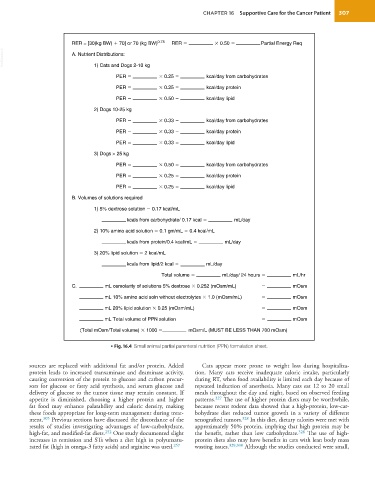Page 329 - Withrow and MacEwen's Small Animal Clinical Oncology, 6th Edition
P. 329
CHAPTER 16 Supportive Care for the Cancer Patient 307
RER = [30(kg BW) 70] or 70 (kg BW) 0.75 RER 0.50 Partial Energy Req
VetBooks.ir A. Nutrient Distributions:
1) Cats and Dogs 2-10 kg
PER 0.25 kcal/day from carbohydrates
PER 0.25 kcal/day protein
PER 0.50 kcal/day lipid
2) Dogs 10-25 kg
PER 0.33 kcal/day from carbohydrates
PER 0.33 kcal/day protein
PER 0.33 kcal/day lipid
3) Dogs > 25 kg
PER 0.50 kcal/day from carbohydrates
PER 0.25 kcal/day protein
PER 0.25 kcal/day lipid
B. Volumes of solutions required
1) 5% dextrose solution 0.17 kcal/mL
kcals from carbohydrate/ 0.17 kcal mL/day
2) 10% amino acid solution 0.1 gm/mL 0.4 kcal/mL
kcals from protein/0.4 kcal/mL mL/day
3) 20% lipid solution 2 kcal/mL
kcals from lipid/2 kcal mL/day
Total volume mL/day/ 24 hours mL/hr
C. mL osmolarity of solutions 5% dextrose 0.252 (mOsm/mL) mOsm
mL 10% amino acid soln without electrolytes 1.0 (mOsm/mL) mOsm
mL 20% lipid solution 0.25 (mOsm/mL) mOsm
mL Total volume of PPN solution mOsm
(Total mOsm/Total volume) 1000 mOsm/L (MUST BE LESS THAN 700 mOsm)
• Fig. 16.4 Small animal partial parenteral nutrition (PPN) formulation sheet.
sources are replaced with additional fat and/or protein. Added Cats appear more prone to weight loss during hospitaliza-
protein leads to increased transaminase and deaminase activity, tion. Many cats receive inadequate caloric intake, particularly
causing conversion of the protein to glucose and carbon precur- during RT, when food availability is limited each day because of
sors for glucose or fatty acid synthesis, and serum glucose and repeated induction of anesthesia. Many cats eat 12 to 20 small
delivery of glucose to the tumor tissue may remain constant. If meals throughout the day and night, based on observed feeding
appetite is diminished, choosing a higher protein and higher patterns. 327 The use of higher protein diets may be worthwhile,
fat food may enhance palatability and caloric density, making because recent rodent data showed that a high-protein, low-car-
these foods appropriate for long-term management during treat- bohydrate diet reduced tumor growth in a variety of different
ment. 305 Previous sections have discussed the discordance of the xenografted tumors. 328 In this diet, dietary calories were met with
results of studies investigating advantages of low-carbohydrate, approximately 50% protein, implying that high protein may be
high-fat, and modified-fat diets. 252 One study documented slight the benefit, rather than low carbohydrate. 328 The use of high-
increases in remission and STs when a diet high in polyunsatu- protein diets also may have benefits in cats with lean body mass
rated fat (high in omega-3 fatty acids) and arginine was used. 257 wasting issues. 329,330 Although the studies conducted were small,

